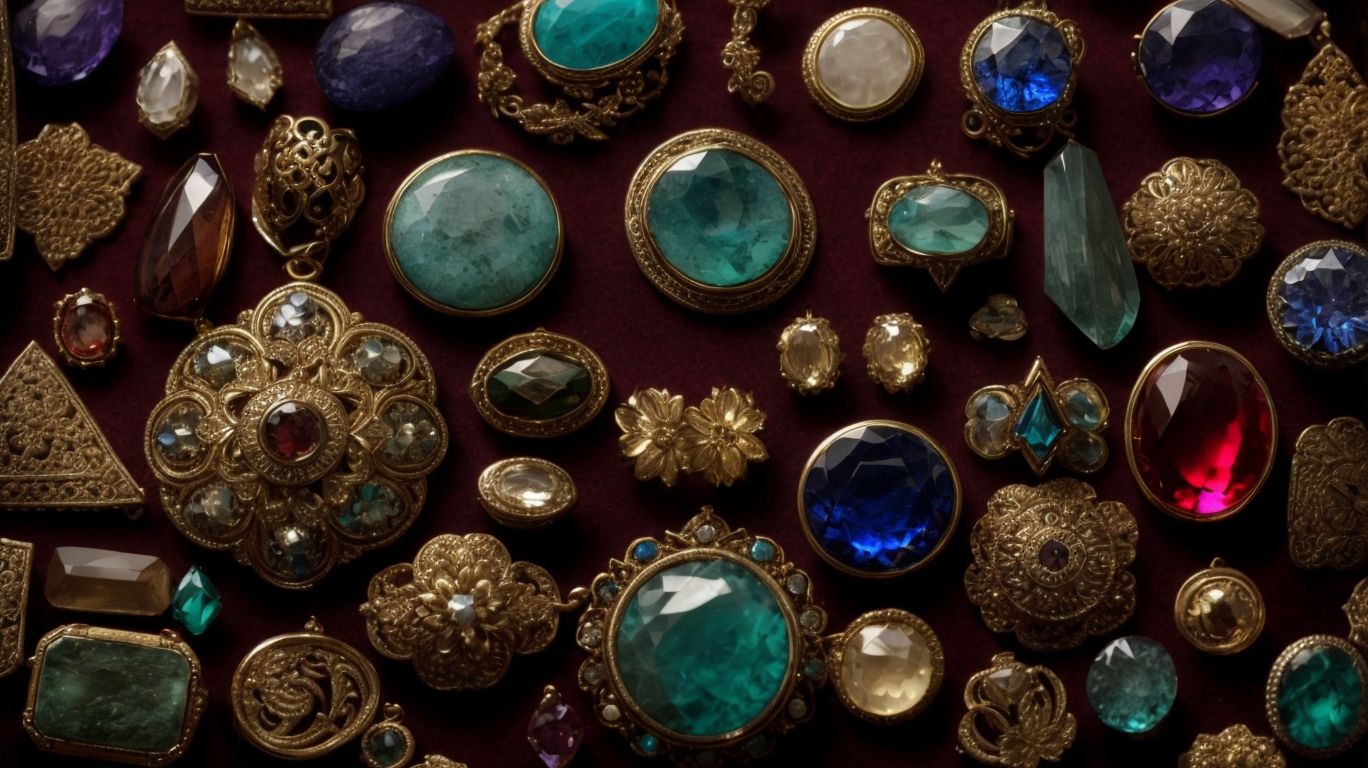
Talismans of the Ages: Gemstone Legends from Medieval and Renaissance Eras
Curious about the mystical world of talismans and gemstones?
Explore the enchanting legends surrounding these precious stones from the Medieval and Renaissance eras.
Discover the fascinating folklore behind gemstones like sapphires, emeralds, rubies, and more, and how they were believed to possess magical powers.
Learn how these gemstones were used as talismans for protection, healing, good luck, and spiritual connection in ancient times.
Uncover the modern-day beliefs and uses of gemstones as talismans in our article.
What Are Talismans?
Talismans are objects imbued with magical powers and symbolism, believed to offer protection, luck, or specific abilities to their bearers.
Throughout history, talismans have been revered for their mystical significance and the idea that they can harness supernatural forces to ward off evil or attract good fortune. Different cultures and civilizations have their own interpretations and beliefs when it comes to talismans, with some considering them as charms for love, prosperity, or even healing. The power of a talisman is often thought to reside in the intention of its creator and the personal connection it forms with the wearer, creating a bond that enhances its effectiveness.
What Are The Different Types Of Talismans?
Various types of talismans exist, including charms, amulets, enchantments, and artifacts, each with its unique purpose and magical properties.
Charms, often worn as jewelry or carried on a person, are believed to bring good luck and protection.
Amulets, on the other hand, are objects imbued with specific powers to ward off evil or attract positive energy.
Enchantments involve spells or writings that are believed to hold magical powers and can be inscribed on various items.
Artifacts, with their deep historical significance, are ancient objects believed to carry mystical forces or connections to powerful beings or events, adding layers of enchantment to their essence.
What Are Gemstones?
Gemstones are precious minerals renowned for their beauty, rarity, and symbolic significance in various mythologies, lores, and cultural beliefs.
Throughout history, gemstones have held a special place in human society, reflecting values, beliefs, and traditions across different civilizations. The ancient Egyptians believed in the protective power of stones like lapis lazuli, while the Greeks associated certain gems with specific gods and goddesses. Gemstones have been used not only as adornments but also as talismans, with each stone carrying unique properties and meanings. From the sparkling allure of diamonds to the mystical charm of opals, these precious jewels continue to captivate and inspire people worldwide.
How Were Gemstones Used In Medieval And Renaissance Times?
During the Medieval and Renaissance eras, gemstones held profound significance, often integrated into various aspects of life, including superstitions, folklore, and ceremonial practices.
Gemstones were believed to possess mystical powers and were frequently used as talismans and amulets to ward off evil spirits or attract good fortune. In Medieval times, certain gems like amethyst were associated with protection against intoxication, while diamonds symbolized purity and strength. The Renaissance period saw an increased interest in the symbolic meanings of gemstones, with rubies representing passion and love, and sapphires signifying loyalty and wisdom.
Gemstones were not only prized for their beauty but also valued for their supposed healing properties, leading to their widespread use in medicinal remedies and alternative therapies.
What Are The Legends Surrounding Gemstones In Medieval And Renaissance Eras?
The Medieval and Renaissance periods abound with legends surrounding gemstones, often intertwined with mythical creatures, diverse mythologies, and spiritual beliefs.
Gemstones were believed to possess mystical powers that could protect their owners from harm, bring prosperity, and even grant wishes. For example, ancient texts suggest that wearing a ruby could ward off illness and evil spirits, while a sapphire was thought to represent purity and wisdom. Diamonds, with their brilliance and rarity, were associated with divine energy and spiritual enlightenment. These beliefs fueled a fascination with gemstones, leading to the creation of elaborate jewelry and amulets imbued with both beauty and meaning.
The Legend Of The Sapphire
The legend of the sapphire weaves a narrative of mythos and spirituality, portraying this gemstone as a symbol of protection and wisdom in various cultural beliefs.
Its celestial hues have long been associated with celestial realms, believed to aid in spiritual enlightenment and stimulate psychic abilities. In ancient Persia, sapphires were considered talismans of power, granting their wearers favor with the divine forces. Similarly, in Hindu traditions, the sapphire was revered as a sacred stone connected to Saturn, symbolizing truth and sincerity. Across cultures, sapphires have been linked to loyalty, integrity, and inner peace, making them sought after for their harmonizing energies.
The Legend Of The Emerald
In folklore and mystical traditions, the emerald is revered for its enchanting beauty and occult properties, often associated with luck, love, and healing powers.
Legend has it that wearing emeralds can bring forth prosperity and abundance, enhancing one’s intuition and insight. Throughout history, emeralds have been worn by royalty and nobility as a symbol of power and prestige. Ancient cultures believed that gazing into the deep green depths of an emerald could reveal truths and uncover hidden mysteries.
The emerald’s rich green color was also thought to symbolize rebirth and renewal, making it a popular choice for amulets and talismans to ward off negative energies.
The Legend Of The Ruby
The legend of the ruby embodies beliefs in its talismanic properties, revered in esoteric traditions and mythologies for its association with vitality, passion, and protection.
In ancient folklore, the ruby was often considered a crystal of power and energy, believed to enhance courage and strength. It was said that warriors would wear rubies into battle for protection and victory. The deep red hue of the ruby symbolized love and passion, making it a favored gemstone for matters of the heart. Across various cultures, the ruby was also associated with wisdom and prosperity, believed to bring good fortune to those who possessed it.
The Legend Of The Amethyst
The legend of the amethyst is steeped in symbolic meanings and mysteries, attracting talismanists and spiritual seekers with its aura of protection and intuition.
For centuries, the amethyst has been revered for its ability to ward off negative energies and enhance intuitive abilities. Believed to promote clarity of mind and spiritual insight, this captivating gemstone is often used as a protective talisman against psychic attacks and unwanted influences. Its deep purple color is associated with royalty, wisdom, and spiritual connection, making it a popular choice for meditation and spiritual practices. The amethyst’s enigmatic allure continues to fascinate those who seek its transformative and healing energies in their lives.
The Legend Of The Diamond
The legend of the diamond is shrouded in mythopoeia and mythic narratives, portraying this precious gem as a symbol of power, purity, and eternal love.
Throughout history, the diamond’s radiant beauty has captivated cultures worldwide, leading to beliefs in its divine origins and protective qualities. In various mythologies, diamonds are often associated with gods and goddesses, highlighting their connection to the celestial realm. The diamond’s enduring nature held significance as a talisman for strength and resilience, reflecting its mythic attributes as a symbol of invincibility and courage. Its brilliance served as a beacon of hope in dark times, embodying the mythic archetype of light triumphing over darkness.
The Legend Of The Pearl
The legendary tale of the pearl intertwines with mythological lore and talismanic beliefs, attracting talismanists with its talismanic properties and mystical allure.
Pearls have long been revered for their connection to purity and divine energy in various cultures throughout history. According to ancient legends, pearls were believed to be the tears of gods or celestial beings, imbuing them with powerful protective energies. Talismanists seek out pearls for their ability to bring luck, ward off evil spirits, and enhance one’s inner strength. The lustrous beauty and rarity of pearls also add to their appeal as precious talismans, capable of bestowing their wearer with blessings and harmonious energies.
The Legend Of The Opal
The enigmatic legend of the opal symbolizes mysticism and mysteries, evoking mythographies that depict this gem as a bearer of both good fortune and ill omens.
Some ancient beliefs suggest that wearing opals could bring luck and promote creativity, while others caution that they must be handled with care to avoid attracting misfortune. In various cultures, opals are associated with protection, love, and emotional healing, adding to their mystical appeal.
The opal’s shimmering iridescence is said to reflect the wearer’s emotions, acting as a mirror to their soul. The interplay of light within the stone is often likened to the dance of cosmic energies, enhancing its status as a mystical talisman.
The Legend Of The Moonstone
The ethereal legend of the moonstone is steeped in mythologizing and occultism, revered by talismanists for its talismanic properties and mystical connections to lunar energies.
Its mystical allure is said to be tied to ancient beliefs that the moon governs the ebb and flow of life’s energies, with the moonstone acting as a conduit for harnessing these ethereal forces. Legend has it that wearing a moonstone can enhance intuition, channel inner wisdom, and bring about emotional balance. In occult circles, the moonstone symbolizes femininity, intuition, and psychic abilities, making it a sought-after tool for those looking to unlock hidden truths and delve into the mysteries of the subconscious mind.
How Were Gemstones Used As Talismans In Medieval And Renaissance Times?
Gemstones served as powerful talismans during the Medieval and Renaissance periods, harnessing their inherent powers for protection, healing, and spiritual connections.
These precious stones were not just valued for their aesthetic appeal but also for their believed ability to ward off evil spirits, provide physical healing, and deepen one’s spiritual practices.
In Medieval times, individuals often wore gemstone amulets or carried them in pouches, attributing specific powers to different stones based on their colors and compositions.
The Renaissance era saw an increased interest in the symbolism tied to gemstones, with various texts and manuals detailing the protective and healing properties of stones like amethyst, bloodstone, and turquoise, further elevating the mystique surrounding these talismans.
For Protection
Gemstones were often employed for protection through talismanic practices, drawing upon mythographic beliefs and esoteric traditions to safeguard the wearer from harm.
Throughout history, various cultures have revered gemstones for their perceived ability to repel negative energies and attract positive influences. Talismanic rituals, deeply ingrained in ancient civilizations, frequently involved the use of specific gemstones believed to possess unique protective properties. Influenced by the stories of gods and heroes from mythological traditions, individuals sought to harness the power of these precious stones for their amuletic qualities.
Esoteric practices further enhanced the allure of gemstone talismans, with intricate symbolism and rituals creating a mystical connection between the wearer and the protective energies imbued within the stones.
For Healing
Gemstones were believed to possess healing properties when used as talismans, steeped in mythological lore and mystical mysteries that attributed curative powers to these precious stones.
The ancient Egyptians, for example, revered gemstones such as lapis lazuli for their connection to the divine and their ability to enhance spiritual well-being. Similarly, in Chinese culture, jade was prized not only for its beauty but also for its protective qualities, believed to ward off negative energies and bring about harmony. Throughout history, gemstones like amethyst, known for its calming energy, have been used in talismanic healing traditions to alleviate stress and promote balance in the body and mind.
For Good Luck
Gemstones were sought after as talismans for attracting good luck, revered by talismanists for their symbolic meanings and enchanted qualities believed to bestow fortune and prosperity.
Throughout history, various cultures have ascribed mystical powers to different gemstones, associating them with specific attributes and virtues. The enchanting allure of gemstones lies not only in their physical radiance but also in the spiritual significance they hold.
For centuries, individuals have adorned themselves with these precious stones as a means of warding off negative energies and attracting positive vibes. From ancient civilizations to modern-day practices, the belief in gemstones as bearers of luck and prosperity continues to captivate the hearts and minds of those seeking a touch of magic in their lives.
For Spiritual Connection
Gemstones were utilized as talismans to deepen spiritual connections, with roots in occultism and talismanic practices that sought to enhance the wearer’s spiritual awareness and metaphysical bonds.
These precious stones were believed to contain unique energies that resonated with the spiritual realm, acting as conduits for higher vibrations and esoteric wisdom.
Throughout history, gemstone talismans have been revered for their ability to protect against negative energies, attract abundance, and promote inner balance.
From Ancient Egypt to Medieval Europe, cultures worldwide have incorporated gemstones into rituals and ceremonies, attributing specific meanings and powers to each gemstone based on its color, composition, and energetic properties.
What Are The Modern Day Beliefs And Uses Of Gemstones As Talismans?
In modern times, gemstones continue to be revered as talismans, embodying spiritualism and mythic qualities that resonate with individuals seeking personal connections and metaphysical energies.
These gemstones, believed to hold unique energy frequencies, are often utilized in contemporary practices such as crystal healing, meditation, and energy work. Each gemstone is associated with specific properties and meanings, ranging from promoting clarity and focus to enhancing creativity and protection.
People from various backgrounds find solace and guidance in the symbolic language of gemstones, viewing them as tools for empowerment and self-discovery. The trend of wearing gemstone jewelry not only adds a fashionable touch but also serves as a reminder of intentions set and energies invoked.




No Comments